| ||||||||
| Early in 1997 The Times of London carried a report suggesting how the ruins of Plato's Atlantis could exist in the highland wilderness of the Bolivian Andes mountains. It was not the first time that such an idea had been proposed and similar theories of a great cataclysm in the Andes stem from much earlier. | ||||||||
| Plato's account of Atlantis came from a Greek lawgiver Solon, who had talked with Egyptian priests. According to the Egyptians, Atlantis was an island in the Atlantic Ocean lying to the west of the Straits of Gibraltar. It was a rich land the size of Asia Minor and Libya combined. with rulers who were powerful princes. These rulers became so wicked and unrighteous that the gods were displeased and eventually a natural cataclysm occurred. Atlantis was overwhelmed by the sea and vanished. Solon who is remembered as one of the 'Seven wise men of Greece' was born in Athens c 630 BCE and died c 560 BCE. The priests told him how the cataclysm occurred about 9000 years earlier. | ||||||||
| The
Andean plains of Bolivia are thousands of miles from the Straits of Gibraltar
and reach an altitude of 3,900m. So how could Atlantis be there? Legends and Gods Some of earliest European documents made after the 'first contact' with Andean people are filled with local legends. Stories told and re-told from the dawn of time bear an uncanny resemblance to Plato's record of Atlantis as told by the Egyptians. A cataclysmic flood destroyed an ancient race of people who had 'displeased the gods'. So runs the Andean creation myth. 'The world became dark and the people lived in caves......' | ||||||||
| ||||||||
| What a story these people could tell? The faces were carved about 1500 years ago. Some have stood on the windswept plain, exposed to the elements. Others were found buried under several metres of mud. Just out of the picture to the bottom left is the site of the Pumapunku. This is another 'temple area' with many finely cut stones some weighing over 100 tonnes. Its position to the south of the Akapana may have been important because it gave a good view to a sacred mountain far to the east. Of course there is no certainty that this was the reason as the ancient builders left no written records. All the legends have been handed down through the generations. Running through many legends the theme of an immense flood dominates. The story was first noted by a Spaniard in the 17th century "they remembered that the sea began to rise and its waters filled the valleys and covered all the hills except for one place. All the animals were there and one Indian and his llama. After five days the water level began to fall and the world began again. All the people living there today are descended from the survivors." If it sounds rather Biblical to you, rest assured it will not be the first time it's been noticed. There are even signs of ancient beaches as far as 60m above the present level of Lake Titicaca and Tiwanaku itself was covered with soil until a reconstruction was begun in the 1960s. So
what happened there? Was there a gigantic flood? -Why do some of the
ancient gods have African features? -Could the Atlantis myth have started in this
once remote place? The story began to be pieced together in the early 1900's by
Arturo Posnansky a German who made his home in Bolivia. Posnansky opened the way for more ideas - and remember that these came from the 1930's and 40's before the age of modern scientific exploration of space. One fascinating suggestion began with a Viennese cosmologist Hans Hoerbiger (1860- 1931) who suggested that our Planet Earth had at some time been passed-close-by or even 'captured' another satellite in its gravitational influence. Such a satellite would have affected the world's tides considerably by forming a 'girdle' of rising water. The sea would have risen hugely and vast areas would have been inundated. This effect would have been noticed around the world thus accounting for the universally known deluge stories. One
of the followers of Hoerbiger's work was Hans Bellamy who wrote extensively on
the subject in the 1950's and made the link between the satellite 'girdle tide'
theory and Tiwanaku. Much of his rationale was founded on his interpretation of
the carvings on the face of the 'Sun Gate'. This ten tonne slab of beautifully
carved Andesite, a local rock, now stands in the northwestern corner of the Kalasasaya.
This may not be its original position and certainly, when the first photographs
were taken in the late 1800's, the arch was broken. The Sun Gate of Tiwanaku A frieze of carved 'Winged Figures' covers the lower part of the gate and is arranged around a central image of what is often called 'T'he Weeping God'. This god is believed to be the 'Creator', variously called Thunupa or Viracocha, sometimes Ticci Viracocha. The 'Viracocha' version of the name probably arrived with Inka mythology when they annexed the area in the 14th century AD. Modern researchers have many suggestions for the meaning and not all agree. But
it is the frieze that attracted the attention of Hans Bellamy and he put forward
the theory that it was a unique calendar. He was not the first to suggest a calendar
theory but his intepretation was extraordinary. He concluded that the Tiwanaku
year was only 290 days. Bellamy's
output of ideas, theories and evidence has never been surpassed. Indeed it has
been largely overlooked in recent years but it is there for anyone to read. Back
in the 1960s Tony Morrison, then a camerman-director and Mark Howell
a writer were producing documentary films for the BBC. Mark's account of the
journeys made with a colleague Allan Reditt who later became a Reuters correspondent,
can be found in 'Journey Through A Forgotten Empire', 1964, published
by Geoffrey Bles, London. This book contains a resumé of Hans Bellamy's
Tiahuanacu Calendar interpretation. Tony and Mark made several journeys to Bolivia
together and among television topics they considered was the 'Mystery of Atlantis'.
They prepared a dossier One
of the most recent searches took explorer Colonel John Blashford-Snell
from Lake Titicaca southwards via the River Desaguadero to Lake Poopo. His discoveries
and conclusion are described in his book 'Kota Mama'. The southern lake
which was once part of a far larger body of water has dried considerably in recent
years but around the edges Aymara Native Americans still live, largely in their
traditional way. Could Atlantis exist below the waters of this shallow Bolivian Lake and what will be found there? Treturn to our index
| ||||||||
|
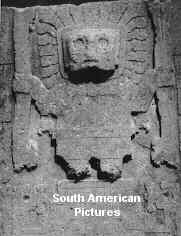
 Even
by stretching the imagination it seems unlikely that Plato knew anything of the
Andes Mountains and anyway, the Egyptian priests said the land was just beyond
the Straits of Gibraltar. If that seems to be the end of the story think again.
Even
by stretching the imagination it seems unlikely that Plato knew anything of the
Andes Mountains and anyway, the Egyptian priests said the land was just beyond
the Straits of Gibraltar. If that seems to be the end of the story think again.
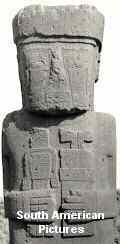
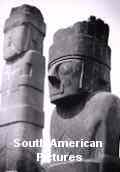
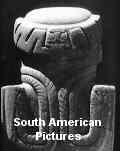
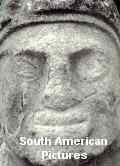
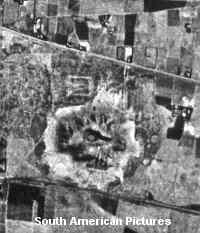 Today
there is little doubt that Tiwanaku was a major ceremonial centre and focal point
of a culture that spread across much of the region. The ancient people built a
pyramid of crude stones known as the Akapana. That structure dominates
the bottom half of this aerial photo. When first recorded the pyramid was largely
covered with earth. After several decades of excavation some of the walls have
been uncovered and treasure hunters opened a depression in the top. This was built
originally to open towards the east. The dark line across the lower part of the
picture is the railway line from a lakeside port to La Paz, the Bolivian capital.
The rectangular outline just 'above and to the left ' of the Akapana is
a terreplein. known as the Kalasasaya. The lighter patch with an
indistinct outline 'above' the Akapana is where an excavated semi-subterranean
'temple' has been discovered. Other features are visible but most of the 'patches'
are fields. The upper part of the picture is crossed by the road from the
the village of Tiwanaku leading eastwards to La Paz. (taken from 'Pathways
to the Gods' by Tony Morrison 1978).
Today
there is little doubt that Tiwanaku was a major ceremonial centre and focal point
of a culture that spread across much of the region. The ancient people built a
pyramid of crude stones known as the Akapana. That structure dominates
the bottom half of this aerial photo. When first recorded the pyramid was largely
covered with earth. After several decades of excavation some of the walls have
been uncovered and treasure hunters opened a depression in the top. This was built
originally to open towards the east. The dark line across the lower part of the
picture is the railway line from a lakeside port to La Paz, the Bolivian capital.
The rectangular outline just 'above and to the left ' of the Akapana is
a terreplein. known as the Kalasasaya. The lighter patch with an
indistinct outline 'above' the Akapana is where an excavated semi-subterranean
'temple' has been discovered. Other features are visible but most of the 'patches'
are fields. The upper part of the picture is crossed by the road from the
the village of Tiwanaku leading eastwards to La Paz. (taken from 'Pathways
to the Gods' by Tony Morrison 1978).  Posnansky devoted much of his life to the study of Tiwanaku, its culture and the
people who lived around it. Posnansky believed he had evidence that Tiwanaku was,
in his words, 'The Cradle of American Man'.
Posnansky devoted much of his life to the study of Tiwanaku, its culture and the
people who lived around it. Posnansky believed he had evidence that Tiwanaku was,
in his words, 'The Cradle of American Man'. 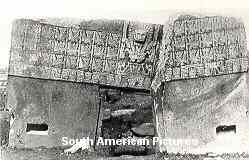
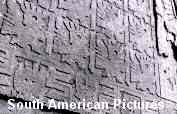 Bellamy also suggested that the frieze symbols also refer to the phases and eclipses
of a satellite, larger than the moon that once circled the earth, So back to girdle
tides - 'the deluge' and the creation myths of the ancient Tiwanakans. Not to
mention the underlying idea that somehow Atlantis could not be far away.
Bellamy also suggested that the frieze symbols also refer to the phases and eclipses
of a satellite, larger than the moon that once circled the earth, So back to girdle
tides - 'the deluge' and the creation myths of the ancient Tiwanakans. Not to
mention the underlying idea that somehow Atlantis could not be far away.
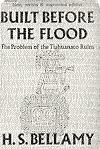 He wrote 'Built Before The Flood' 1953 , ' and with Peter
Allan 'The Calendar of Tiahuanacu' 1956 which contains many detailed
drawings of the frieze, and 'The Great Idol Of Tiahanacu' 1959. Earlier
Bellamy wrote 'The Atlantis Myth' for which The Times of London Literary
Supplement said 'Mr Bellamy makes a speciality of unriddling myths....' All
were published by the British publishers Faber and Faber.
He wrote 'Built Before The Flood' 1953 , ' and with Peter
Allan 'The Calendar of Tiahuanacu' 1956 which contains many detailed
drawings of the frieze, and 'The Great Idol Of Tiahanacu' 1959. Earlier
Bellamy wrote 'The Atlantis Myth' for which The Times of London Literary
Supplement said 'Mr Bellamy makes a speciality of unriddling myths....' All
were published by the British publishers Faber and Faber.  that has remained closed for thirty years. Among the people who were interviewed
were Alicia Posnansky, wife of Arturo Posnansky, Brian Fawcett, the younger son
of the famous British army colonel who disappeared in the 1920's when searching
for ancient cities in Brazil. Colonel Fawcett, like others at the time felt that
there was truth behind the Atlantis myth. (His explorations began in Bolivia)
And finally, Tony and Mark interviewed Egerton Sykes whose passion for the 'unknown'
has become legendary. Part Two of 'THE BOLIVIAN ATLANTIS' will look at
the contents of this previously unpublished dossier and at evidence amassed by
archaeologists.
that has remained closed for thirty years. Among the people who were interviewed
were Alicia Posnansky, wife of Arturo Posnansky, Brian Fawcett, the younger son
of the famous British army colonel who disappeared in the 1920's when searching
for ancient cities in Brazil. Colonel Fawcett, like others at the time felt that
there was truth behind the Atlantis myth. (His explorations began in Bolivia)
And finally, Tony and Mark interviewed Egerton Sykes whose passion for the 'unknown'
has become legendary. Part Two of 'THE BOLIVIAN ATLANTIS' will look at
the contents of this previously unpublished dossier and at evidence amassed by
archaeologists. 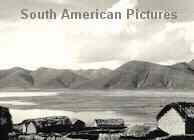 They
are not the only survivors from past times and in this arid and often bleak part
of the Andes Mountains some legends live on.
They
are not the only survivors from past times and in this arid and often bleak part
of the Andes Mountains some legends live on. 